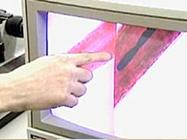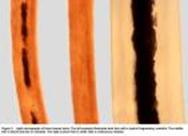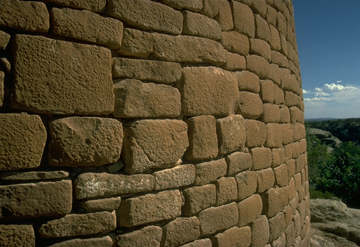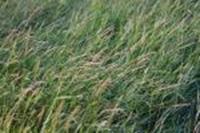
PHYSICAL EVIDENCE
UNIT OVERVIEW: In
this unit, trace evidence will be introduced as a part of physical evidence
collection. Trace evidence will be introduced as the smallest pieces of
evidence at a scene, including fiber, hair, grass, glass fragments, seeds,
dust, and soil. Various examples of trace evidence will be introduced as well
as the method for collection and evaluation, and the significance of such
evidence as related to a court case. This particular unit will introduce human
and animal hair, fibers, dirt and dust, building materials, string and rope,
pollen, plants, seeds, and grass. Students will build a “Forensic
Science Kit” from the list of common
materials provided. Two examples of crime solving techniques will be discussed.
DIRECTIONS: Read the following text, look at the illustrations, and answer the questions. Key terms will be highlighted in bold print.
|
FORENSIC SCIENCE KIT UNIT 03 |
|
|
|
|
|
Newsprint |
Markers |
|
Plastic bags |
Clear adhesive tape or clear book binding tape (2-3 inches in width) |
|
Magnifying glass |
Pencil |
|
White paper |
Baking soda |
|
Cornstarch |
Water |
|
Vinegar |
Paper cups |
|
Teaspoons |
Coffee stirrers or toothpicks |
|
Paper towels |
Optional items for chemical analysis experiment (6 powders are needed): corn starch, salt, powdered sugar, sugar, powdered milk, baking soda |
|
Optional: animal hairs |
Petri dish or small clear plastic bowl with a lid |
|
Lint roller |
Collection envelope (may use a white envelope) |
|
Tweezers (flat edge, not pointed) |
Disposable latex or vinyl gloves |
|
Key Terms |
||
|
physical evidence |
identification |
comparison |
|
class evidence |
cuticle |
cortex |
|
medulla |
secondary transfer |
Palynology |
Physical Evidence
Physical evidence can be described as evidence that includes any and all objects that can establish that a crime has been committed or can provide a link between a crime and its victim or a crime and its perpetrator. This definition was introduced in the last unit. Some of the common types of physical evidence include:
|
~ blood, semen, saliva |
~ paint |
|
~ documents |
~ petroleum products |
|
~ drugs |
~ plastic bags |
|
~ explosives |
~ plastic, rubber and other polymers |
|
~ fibers |
~ powder residues |
|
~ fingerprints |
~ serial numbers |
|
~ firearms and ammunition |
~ soil and minerals |
|
~ glass |
~ tool marks |
|
~ hair |
~ vehicle lights |
|
~ impressions |
~ wood and other vegetative matter |
|
~ organs and physiological fluids |
|
When physical evidence is examined by a forensic scientist, it is usually for the purpose of identification or comparison. Identification is the process of determining the physical or chemical identity of a substance. Comparison is the process of determining if two or more objects have a common origin.
Physical evidence can convict a suspect or it can eliminate them from suspicion. Because it is not known at the time of evidence discovery and collection if the suspect will be exonerated or convicted, it is important to conduct a scientific investigation thoroughly so the evidence speaks for itself.
Trace Evidence
 In
the last unit trace evidence was defined as the smallest pieces of evidence at
a scene, including fiber, hair, grass, fragments, seeds, dust, and soil. Some
of the methods used to collect trace evidence include: picking, lifting,
scraping, vacuum sweeping, combing, and clipping.
In
the last unit trace evidence was defined as the smallest pieces of evidence at
a scene, including fiber, hair, grass, fragments, seeds, dust, and soil. Some
of the methods used to collect trace evidence include: picking, lifting,
scraping, vacuum sweeping, combing, and clipping.
When we are talking about a crime investigation, one of the key issues is the need to individualize any piece of evidence. Items such as fibers, plant seeds, and shoeprints are generally known as class evidence. Class evidence means that the items can be grouped with a class of items like it. The more unique something is when tied to a suspect, the more likely that it will have value to the prosecution process.
Human Hair
Quite often hair is collected at the scene of a crime as physical evidence. In fact, we could say that hair is trace evidence. When hair is examined in the crime lab, the first step is to determine if the hair is human or animal in origin. It is quite easy to distinguish human hair from animal hair with the exception of certain ape species; however, it is not quite so easy to match human hairs to an individual. Hair must be examined under a microscope to determine its unique features. It is then important to determine if the collected hair matches up with an individual suspected of being at the crime scene. Because hair from different parts of the body exhibit a range of characteristics, it is necessary to have numerous other hairs to compare it to.
When hair is compared, the examiner will pay particular attention to the color and length of the hair, as well as the diameter. Other features of importance would include the presence or absence of a medulla and the distribution, the shape of the hair, and the intensity of color pigments in the cortex. Hair examiners divide human hair into six types: head, eyebrow or eyelash, beard or moustache, body, axillary (underarm), and pubic. When hair comparisons are made, head and pubic hair are the most common. It is sometimes possible to determine if the hair has been bleached or dyed to a color that is not natural. If hair has grown in length since the last coloring, it is possible to see the natural color of the hair on the roots. We know that hair grows approximately one centimeter in a month, so it can be determined approximately how long it has been since the hair was colored.

Hair is composed of three layers: the cuticle, cortex, and the medulla. The hard outside covering that protects the inner layers of hair is called the cuticle. Within the cuticle, overlapping scales point towards the tip. The scales are cells that have hardened and flattened. The cortex is made of cells within the cuticle. 75-90% of a human hair is composed of cortex. These cells contain pigments that give hair its color. Forensic scientists can use color, shape, and distribution of pigment granules to tell the difference between hairs of two individuals. The medulla of a hair is made of cells that run through the center of the cortex like a canal. With humans, this is a very small layer. Sometimes the medulla may not be a continuous canal: it may be interrupted, fragmented, or even absent. When forensic scientists determine the medullary index of hair, they take the diameter of the medulla relative to the diameter of the hair, expressed as a fraction. A medullary index of less than 1/3 is found with humans. The medullary index of animals is ½ or greater.

This is an illustration of light micrographs of three human hairs. The left example illustrates dark hair with a typical fragmentary medulla. The middle hair is blond and has no medulla. The right coarse hair is white with a continuous medulla.
Animal Hair
Animal hairs found on items of physical evidence can link a suspect or location to a crime of violence. A victim placed in a vehicle or held at a location where animals are routinely found often results in the transfer of animal hairs to the victim’s clothing. Cat or dog hairs have been found on the adhesive portions of ransom or extortion notes prepared by pet owners. The transfer of pet hairs to the victim or crime scene can also occur when the suspect is a pet owner and has animal hairs on his or her clothing when the contact occurs. This is referred to as a secondary transfer of trace material.
With a few exceptions, animal hairs grow to a specific length, then fall out, usually on the couch. Sheep and some dogs, poodles and bichons frises, have hair that continues to grow and must be cut occasionally. Their hairs could be misidentified by an unaware or inexperienced examiner. Most kinds of animals have two distinctly different types of hairs on their backs: guard and down hairs. Guard hairs are usually coarse and multicolored. Down hairs are fine and much softer. Animal hairs can only be classified by species, as in the type used for a fur coat or those named as endangered creatures. We fill find out later in this unit that animals have their own unique DNA.
Before a comparison of animal hair can be made, a number of hairs need to be collected. Because animal hairs can vary widely in color and length, hairs should be collected from each area. The collected sample should contain full-length hairs and should contain combings as well as pluckings. If the animal is not available for sample collection, a brush or comb used for the animal may be substituted. Even samples from a dog or cat bed may prove useful. Animal hairs found at a crime scene or on the clothing of a suspect and/or victim, may also have originated from a fur coat or pelt. These types of hairs may have been artificially colored or trimmed and often do not have a root.
The Significance of Hair Evidence
The significance of hair evidence results is dependant upon the method of evidence collection used at the crime scene, the evidence processing techniques employed at the crime lab, the method of examining the hair, and the experience of the hair examiner. The significance of a hair match is influenced by how frequently the examiner has observed certain characteristics as well as by how often the examiner has seen hairs of a particular race or body area. Hair evidence is only of value when it is used in conjunction with other evidence.
![]() Forensic
Analysis of Hair (
Forensic
Analysis of Hair (
The Cat Detective Case
 Shirley
Duguay lived on
Shirley
Duguay lived on
The police had also found a man’s leather jacket also stained with blood in the car. They suspected that the jacket belonged to Beamish. Once the body was discovered and the case was reopened, the jacket was returned to the crime for further tests. The forensic scientists found long, white cat hairs on the jacket. One of the detectives remembered seeing a big white cat at Shirley’s home, named Snowball, when he questioned Beamish. They wondered if they could match cat hair the same way that human hairs were matched through DNA.
The detectives
found a scientist who was willing to test Snowball’s fur. They rushed a blood
sample from Snowball and some of the white cat hairs found on the jacket to the
lab in
![]() How
Blood Can Provide Evidence to Help Solve a Crime (
How
Blood Can Provide Evidence to Help Solve a Crime (
Fiber Evidence
Like hair, fibers are physical evidence, or more specifically trace evidence. Fibers can be found at the point-of-entry, on furniture and at other locations which will be discussed in later paragraphs of this section. Fibers cannot pinpoint an offender’s presence; however, their characteristics can be examined for consistency between a known and unknown sample. For example, the carpet fibers found on a watch band are compared to a carpet sample in a victim’s home. The smallest unit of a textile material is a fiber. Fibers are twisted together to make thread and yarn.
Natural fibers come from plants (cotton), minerals (glass or asbestos), or animals (silk, wool, or fur). Some examples of fibers that are manufactured include synthetics such as rayon, acetate, and polyester. When examining these types of fibers, analysts look at the shape and color. Often, an analyst only gets one fiber to examine. This fiber(s) is then compared with fibers from a suspect source, such as a car or home. A comparison microscope is used to inspect the fibers side by side. With person-to-person contact, fibers can be transferred. The ideal scenario is when the fibers can be traced back to the offender and that they can be found at the crime scene as well. The success of solving the crime often hinges on being able to narrow down the sources for the type of fiber found, and then to find a quantity of them. Just like hair, tweezers are used to gather fibers at the crime scene. A vacuum or tape may also be used in the gathering process. When fibers are collected by sweeping or vacuuming, a special filter paper is used. The sweeping and filter paper are collected in an evidence bag. If fibers are located attached to a large object, they should not be removed. The entire object should be packaged and submitted to the lab. If the object is too big, the fiber should be photographed and carefully removed and packaged for analysis. When collecting fibers with tape, the technician takes a five-inch piece of tape and holds each end between the thumb and index finger. The tape is then touched to the surface and this action is repeated a number of times. The tape with the collected evidence is then placed in a plastic Petri dish, covered, and labeled. One piece of tape is usually enough to cover half of a victim’s chest and abdomen, or half of one leg. Fibers may also be collected using a lint roller. The lint roller with the collected fibers can then be placed in a collection envelope and labeled. Sometimes, fibers are collected without the use of an adhesive substance, and are placed directly in the collection envelope and labeled. Fibers usually come from clothing, carpets, draperies, furniture, blankets, and wigs.
Agreement of color and shape of a fiber sample based on consistency moves the analysis process to the next phase; analyzing the texture and dye. During this process, the analyst looks for lengthwise striations or pits on the surface of a fiber, or even unusual shapes. Even when a similarity is seen between fibers from two separate places, this is no proof that they originated from the same source. At the present time, there is not a database that provides a probability of origin.
Fibers can be analyzed by a burn test, solvent/solubility test, a stain test, and microscopic examination.. It takes a series of tests to determine the type of fiber. A burning fiber may give off a particular odor and even leave a residue which is ash-like, brittle, or a hard bead. The solubility test determines if the fiber will dissolve in a particular solvent. A fiber stain test will determine if a fiber will react in a predictable manner with different types of fibers. The microscopic exam will reveal specific markings on the inside of the fiber, folding or twisting, and light transmittance quality.
Dirt and Dust
Is it dirt or
soil or earth? It doesn’t matter …. this trace evidence can help police solve a
crime. Soil is extremely distinctive. Soil samples from one piece of ground can
be very different from soil found just a short distance away. Forensic
scientists can determine the contents of the soil and determine where it came
from. They use detailed charts and maps to help in the determination. One
expert estimates that there are 50,000 varieties of soil found in the
When a person kneels, sits, falls, or digs a hole (perhaps to bury a body), dirt gets embedded in their clothing and shoes and can even make it into pockets and pant cuffs. If a perpetrator has soil on their clothes, that soil might fall on the floor or furniture while they commit a crime. If a suspect is arrested with dirt on their clothes or vehicle, a forensic scientist can determine whether the dirt came from the crime scene. Soil is transported by anything that moves, including vehicles or animals. Moisture causes soil to cling to the tires and to the metal, rubber, or plastic on the outside, inside, or bottom of a vehicle.
Soil analysis can also be concerned with the detection of manufactured objects such as glass, paint chips, asphalt, brick fragments, and cinders, whose presence may leave soil with characteristics that will make it unique to a particular location. If this material is collected deliberately or accidentally in a way that will connect it with the crime scene, then it becomes valuable physical evidence. Some forensic laboratories use a density-gradient tube technique to compare soil specimens. With a density-gradient tube, it is filled with layers of two liquids mixed in varying proportions so that each layer has a different density value. When soil is added to this tube, the soil particles will sink to the portion of the tube that has a density of equal value.

When soil is collected at a crime scene, the variation of soil must be of primary concern. Because of this, soils must be collected at various intervals within a 100-yard radius of the crime scene, as well as at the site of the crime, for comparison studies. Additional samples may be collected from the area around the first sample. Four to eight samples are randomly collected from 3 to 20 feet from the original samples. These samples are used in the lab for comparison. In most cases, the perpetrator will only pick up the top-surface layer of soil. The quantity required by the lab for a comparative analysis is only about one or two tablespoons. When the samples are taken, they must be collected and packaged in individual containers such as plastic vials. And as always, each vial will need to be marked to indicate the location where the sample was collected.
Soil that is found on a suspect needs to be carefully preserved for evidence purposes. If the soil is adhering to an object such as a shoe sole, it should not be removed. In this case the object needs to be wrapped individually in paper, keeping the soil intact, and then sent to the lab for analysis. In the same way, loose soil adhering to clothing should be packaged the same way so that any soil particles that fall off during transportation may be collected in the paper bag.
Large clumps of soil need to be collected and preserved intact if at all possible. In the case of a car collecting large clumps on the fenders and body, etc., the result of an impact may jar some of those large particles loose. The soil found on a car may be matched with large clumps found at the scene of a crime. Keep in mind that a suspect car may be in many locations and will consequently pick up soil from various locations, perhaps over a long period of time.

Dust particles picked up on a suspect’s clothing may also serve to link a suspect to a specific location. It can even help to determine if a victim has been moved. Dust particles can usually yield information about their origins such as from a cement floor, bricks, cement, or a particular room. They might give clues about where someone lives or works. Dust can be equally as specific as dirt. Some house dust contains particles that are unique to the rooms from which it was collected. Bathroom dust may contain talcum powder and cosmetics, while there is often flour and ground spices found in kitchen dust. Ink droplets and paper fibers can be collected on the clothes of printers. Yeast spores cling to brewers and bakers.
When dust particles are collected, a control sample also needs to be collected. This control sample must be characteristic of dust found at the scene of the crime. If dust is present on clothing, the clothing must be carefully removed and bagged. When comparing dust particles, the size of the particles must be examined as well as the density gradient. Most often, a scanning electron microscope is used in this process.
A complete analysis of soil or dust is quite time consuming. But fortunately the need to do this is rare. Most times the investigators want evidence that matches the suspect with the crime scene. Other environmental clues such as sand can be compared by the particle shape. In fact, ocean sand and desert sand have quite different and distinct shapes.
Building Materials
Building materials can qualify as trace evidence. Some examples might include: mortar, brick, stucco, cement, glass, wood, plaster, paint, asbestos, insulation, and even metal fragments. Anything small enough to be picked up on the clothing of a suspect is considered trace evidence. Building materials are characterized by physical, chemical, and microscopic methods. Class characteristics can be proven, however, unless the trace material is determined to be an exact “fit or match” to an object or surface at a crime scene, it cannot be linked to a specific location. There are special chemical and spectographical techniques used to help identify metal shavings or filings. However, as with other building materials, only the class characteristics can be proven.

String, Rope, and Containers
String, rope, and container can be considered trace evidence. What is important with these items is that the trace material may adhere to their surfaces. Rope used in a crime may contain traces of skin cells on its surface. Any knots found in string or rope should not be untied, if possible, as they may contain some valuable evidence. Rope and string recovered from a victim can be compared with samples discovered at the crime scene. The kind of material, the number of strands, the direction of twist and weave pattern, color, diameter, and even the weight per unit length can provide comparison evidence. Containers of these items are often left behind at the scene of a crime, and may yield latent fingerprints, or often the name and address of the criminal.

Palynology
Palynology is the study of pollen. Pollen can be trapped in or found on materials associated with a crime. If this is the case, at this point, forensic botanists become involved in the case. Pollen can help to link a suspect to the crime scene because of its production and dispersal in specific regions. The proportion of different pollen types, called a “pollen signature”, can be found on a suspect’s clothing. This has been used to help narrow search areas for buried bodies. Pollen provides chronological information. The presence of pollen on clothing not only places a suspect or victim at a particular place, but also indicates the season that they were there. As with other types of plant evidence, pollen can be considered valuable circumstantial evidence.
Plants and Seeds
Plants, like soil, can vary from one location to another. Plants that grow in one type of soil may not survive in a different type only a short distance away. The study of seeds can also offer clues. Seeds, just like pollen, can provide chronological clues. DNA testing can identify plants and seeds as positively as it identifies people. Anything that is made of wood can also be considered plant material. Wood can be analyzed for :
~ the type of tree it is from
~ the color and coarseness of the grain
~ the existence of tool marks
~ paints, stains, varnishes, or lacquers that may have been applied to the wood
~ any natural marks on the wood, such as the tree rings used to date the tree
Microscopic examination is able to reveal the type of wood, whether it is hard or soft, even the portion of the tree where it was once located. Tools used on wood will even leave their own individual “fingerprint” marks on the wood. On occasion, the wooden handles of tools are chapped or splintered leaving their matching pieces at the crime scene.
Also included under this topic are other botanical materials such as leaf debris and fungal spores. These may be highly important because they can provide highly specific information as well as pollen and seed materials.

Pieces of Grass
This case,
involving pieces of grass as evidence, happened in
When the chief
of the Chemical and Toxicological Lab examined enlarged crime scene photos, he
noticed that the body was lying in an unusual type of grass. The investigators
found the same type of grass seeds in the pockets and trouser cuffs of Anibal.
Anibal had told the police that he had not been in the park for more than two
years. He said that the seeds must have come from a recent visit to another
park in the area. A professor of botany later testified in court that the grass
in question was extremely rare and it only grew in two spots in the area. It
grew in parts of
Anibal
panicked and told the police that he suddenly remembered walking in
Unit Extensions
Chemical Analysis:
We know that a chemical analysis can help solve a crime. With the following activity, you will compare a substance left at the “crime scene” with some known samples. Collect six different kinds of powders found in your kitchen such as: corn starch, salt, powdered sugar, sugar, powdered milk, and baking soda. Have a friend help you with this experiment. Don’t look while a friend selects one as the sample and then see if you can identify it. Note the characteristics of the substance. Next, analyze each of the samples. What kind of tests will help you to gain more information? Which one matches the substance your friend selected? Make a table of each substance’s characteristics. In question #20 of this unit, you will have the opportunity to share the results of this experiment.
Tape Lift:
Use the roll
of adhesive tape found in your forensic kit to complete this activity. Using
scissors, cut strips of about five inches in length. Practice the procedure
that was discussed earlier in the unit. Use the tape to collect various samples
of trace evidence. Place the samples in a Petri dish and label. Use the lint
roller from your kit to obtain more trace evidence samples. Again, place in an
evidence bag and label appropriately. Last, gather an example of
"trace" using the tweezers found in your kit and place the sample
directly in an evidence bag. Label accordingly. Always make sure you wear latex
or vinyl gloves when collecting evidence. By completing these activities and
following the
guidelines outlined in this unit, you have collected evidence just like the
professionals do.
Who Did It?
The following link
features a fun lab activity that you can do with your friends or family
members. In this lab you will apply the principles of forensic science to a
hypothetical crime. FUN LAB ACTIVITY
This web site is also one found on the discovery.com site. In this experiment you will become familiar with two chemical tests that can be used to identify unknown substances.
To complete
the experiment click on this PDF File
Observation of Animal Hairs:
If you have access to a microscope, it is interesting to look at samples of various species of animal hairs. The hairs are quite different from species to species. Use a variety of tame animals and hair from farm and wild animals if you are able to obtain the samples.
Related Forensic Career – Forensic
Geologist
A forensic geologist can determine where a person or object has been by analyzing soil samples. Forensic geology is a merge between forensics and geology. So simply put, forensic geology is the use of geology (the study of time and pressure) in forensics (the use of science and technology to investigate and establish facts in criminal or civil courts of law). Rocks, soil and dirt, all things associated with geology, can tell stories which can lead to a crime being solved.
Forensic Geology has been used to solve murders, and other crimes, by gathering trace amounts of soils and/or rocks from the belongings of the accused. These traces are then tested for their geological make-up, and then that make-up (think of it as a rock’s DNA) is used to conduct a search of where that type of soil or rock may have come from.
In order to become a forensic geologist, you must have a college degree and related experience. To learn more about this career do a web search. If you are interested in forensic geology mystery novels, you might want to check out the novels by Sarah Andrews. She has published seven forensic geology novels. Check out your local library to see if these novels are available in your area.
Forensic-Related Television
Programs
The following
forensic-related television programs can be viewed on the following list of
channels. These programs are in no way endorsed by this author or the
Court TV ….Forensic Files
Fox channel ….
A & E …. Cold Case Files
Lifetime …. Unsolved Mysteries
Learning Channel …. The Secrets of Forensic Science
Discovery Channel …. The New Detectives
CBS …. C.S.I., C.S.I. Miami, C.S.I.
CBS …. Navy NCIS
NBC …. Crossing
Conclusion
The value of physical evidence (trace evidence) varies from type to type and case to case. The case is only as good as the collector of the trace evidence or the skills of the examiner. In some instances, it is a matter of the availability of trained people who can respond to the scene of a crime and collect the appropriate evidence. And in some investigations, the potential of trace evidence is never fully appreciated.